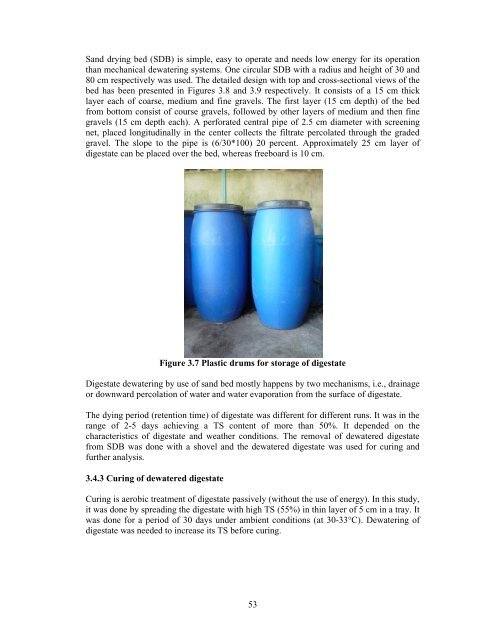dry anaerobic digestion of municipal solid waste and digestate ...
dry anaerobic digestion of municipal solid waste and digestate ...
dry anaerobic digestion of municipal solid waste and digestate ...
You also want an ePaper? Increase the reach of your titles
YUMPU automatically turns print PDFs into web optimized ePapers that Google loves.
S<strong>and</strong> <strong>dry</strong>ing bed (SDB) is simple, easy to operate <strong>and</strong> needs low energy for its operation<br />
than mechanical dewatering systems. One circular SDB with a radius <strong>and</strong> height <strong>of</strong> 30 <strong>and</strong><br />
80 cm respectively was used. The detailed design with top <strong>and</strong> cross-sectional views <strong>of</strong> the<br />
bed has been presented in Figures 3.8 <strong>and</strong> 3.9 respectively. It consists <strong>of</strong> a 15 cm thick<br />
layer each <strong>of</strong> coarse, medium <strong>and</strong> fine gravels. The first layer (15 cm depth) <strong>of</strong> the bed<br />
from bottom consist <strong>of</strong> course gravels, followed by other layers <strong>of</strong> medium <strong>and</strong> then fine<br />
gravels (15 cm depth each). A perforated central pipe <strong>of</strong> 2.5 cm diameter with screening<br />
net, placed longitudinally in the center collects the filtrate percolated through the graded<br />
gravel. The slope to the pipe is (6/30*100) 20 percent. Approximately 25 cm layer <strong>of</strong><br />
<strong>digestate</strong> can be placed over the bed, whereas freeboard is 10 cm.<br />
Figure 3.7 Plastic drums for storage <strong>of</strong> <strong>digestate</strong><br />
Digestate dewatering by use <strong>of</strong> s<strong>and</strong> bed mostly happens by two mechanisms, i.e., drainage<br />
or downward percolation <strong>of</strong> water <strong>and</strong> water evaporation from the surface <strong>of</strong> <strong>digestate</strong>.<br />
The dying period (retention time) <strong>of</strong> <strong>digestate</strong> was different for different runs. It was in the<br />
range <strong>of</strong> 2-5 days achieving a TS content <strong>of</strong> more than 50%. It depended on the<br />
characteristics <strong>of</strong> <strong>digestate</strong> <strong>and</strong> weather conditions. The removal <strong>of</strong> dewatered <strong>digestate</strong><br />
from SDB was done with a shovel <strong>and</strong> the dewatered <strong>digestate</strong> was used for curing <strong>and</strong><br />
further analysis.<br />
3.4.3 Curing <strong>of</strong> dewatered <strong>digestate</strong><br />
Curing is aerobic treatment <strong>of</strong> <strong>digestate</strong> passively (without the use <strong>of</strong> energy). In this study,<br />
it was done by spreading the <strong>digestate</strong> with high TS (55%) in thin layer <strong>of</strong> 5 cm in a tray. It<br />
was done for a period <strong>of</strong> 30 days under ambient conditions ( at 30-33°C). Dewatering <strong>of</strong><br />
<strong>digestate</strong> was needed to increase its TS before curing.<br />
53

















